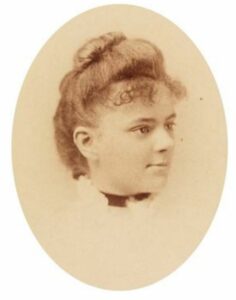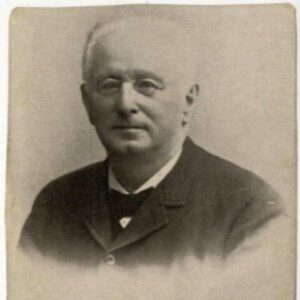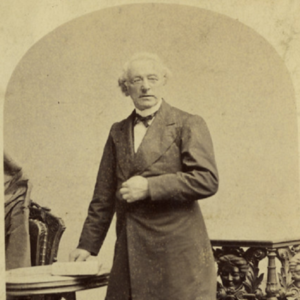(See also Women Doctors in Cincinnati and their Connections to Walnut Hills.)
Sisters Elizabeth and Emily Blackwell grew up in Walnut Hills in the 1830s and ‘40’s. Elizabeth, the elder, decided to become a doctor. She left our city to teach in a school in North Carolina run by a retired doctor, who allowed her to use his medical library. She also studied with a practicing doctor there, which rendered her well-qualified for medical school. With the support of these allies, Elizabeth began applications to medical school.
After many rejections Elizabeth Blackwell found her way to Geneva Medical College in upstate New York. She earned her degree as Doctor of Medicine in 1849 – the first MD awarded to an American woman. Emily found a slightly easier path into Rush Medical College in Chicago. Her road was not smooth; owing to her sex she was refused readmission after her first year. She persisted, transferred to Western Reserve in Cleveland, and earned her own MD in 1854 – probably not the third American woman, as is often claimed, to complete medical training in the US. It is also significant that each sister, after earning an American degree, travelled abroad for further study – Elizabeth to London and Paris, and Emily to Edinburgh and then a whirlwind year in England, France, and Germany.[1]
The Blackwell sisters settled in New York during the 1850s and established an “Infirmary” – sort of a clinic dispensing advice and medicine to poor women and children. Several years of growing success allowed them to expand their infirmary into a small hospital for the same patient base. During the Civil War the doctors Blackwell trained women as nurses to serve in the Union war effort. With the cessation of hostilities, they expanded their hospital and opened the “Women’s Medical College of the New York Infirmary” in 1868. The faculty included both Blackwell sisters and Elizabeth’s protégé Dr. Marie Zakrzewska. It necessarily employed number of male doctors on the faculty as well.
Among the men at the Women’s Medical College, an immigrant from Munich named Samuel Lilienthal taught the course on materia medica, or curative medicines. Ironically this immigrant discovered homeopathy – a German system of plant-based cures – in his adopted New York. He quickly became the leading homeopath in the US, publishing key textbooks adopted by homeopathic medical schools and many others in America. Lilienthal’s 1878 Homeopathic Therapeutics expanded on his earlier publications. He improved the work in two further editions, the third published in 1890. (A fourth edition, in 1904, was an early example of a standard medical text maintained after an author’s death to include new and corrected materials.)[2]
Samuel had arrived in New York in the mid-1840s with his brother Rabbi Max Lilienthal, a leader in Reform Judaism in Germany, then in Russia, then in New York. In 1855 Max Lilienthal moved to Cincinnati, a center of the Reform movement more important even than his brother Samuel’s Brooklyn. In our city Max Lilienthal joined the more famous Rabbi Isaac Wise, each in charge of an important Reform congregations, and both editors with the influential newspaper The American Israelite. Cincinnati was a leading German town in America in the years after the failed reforms in Europe in 1848, and a center for radical German thinkers. Among the reforms embraced by Lilienthal, increasing integration of women into worship and decision-making – paralleling Samuel’s embrace of women into the medical world at the Blackwell sisters’ medical school.
In one respect, at least, Cincinnati proved too provincial to properly support its Reform community. Max wrote to his brother Samuel bemoaning the poor quality of medical care in the Queen City, especially for Jewish women. We have previously met Elmira Howard, a Civil War widow who enrolled in the first class of the Women’s Medical College of the New York Infirmary. The rabbi’s appeal to his medical brother provided the opening for Elmira Howard’s medical career in Cincinnati.[3]
It was Samuel Lilienthal who offered the course on materia medica to Elmira Howard. Samuel touted the newly minted woman MD as a suitable fit for the Reform community in Cincinnati, and Max agreed to recommend her to his congregation. The Ohio-born woman, a Christian, moved to Cincinnati to counsel and heal the women and children of the growing Reform flock in both Lilienthal’s Mound Street congregation and the Plum Street Temple led by Rabbi Wise.
If the connection to Reform Judaism explains Elmira Howard’s location in Cincinnati, it also inspired her next career move. For advanced medical training, American doctors almost always studied in Europe – both Blackwell sisters did so in the 1850s, and men with even the most prestigious American MDs continued the grand educational tours into the first decades of the twentieth century. We have seen elsewhere that Elmira Howard took a sabbatical from her Cincinnati practice in the early 1870s for post-graduate study in Vienna for a year.[4]
Vienna’s Medical School was certainly a fine one, but it had more important connections for Dr. Howard’s patients. In the second half of the nineteenth century, the Austrian city saw a true Jewish Renaissance. Elmira Howard’s choice of Vienna is consonant with her connection through Max Lilienthal to the Reform Jewish synagogues, and the emerging community that in the late 1870s would open Hebrew Union College in our city to train Rabbis in the new American Judaism.
There is of course no particularly Jewish medicine. What Elmira Howard would have learned in Vienna was thoroughly modern European medicine. What is more important is that she would have absorbed the vibrant Jewish culture in the school and the city of Vienna. By the 1870s, something like a third or half of the students at the medical school were Jewish, as were a significant number of professors. Nuances of language, respectful bedside manner, culturally appropriate responses to family concerns, joy and grief, the communication of difficult prognoses – Dr. Howard would have absorbed this culture. Her bedside manner would be familiar to the first-generation immigrants she treated in Cincinnati. These subtilties have always been crucial to the practice of medicine, and even to patient outcomes.
Geoff Sutton
For more on Dr. Howard, see Elmira Young Howard, and A view from Across the Sea.
[1] Janice P. Nimura, The Doctors Blackwell: How Two Pioneering Sisters Brought Medicine to Women and Women to Medicine (Norton, 2020) is a thorough joint biography, and follows Emily’s career as a teacher and administrator in New York. A review of the book by Casey Cep in the New Yorker magazine, 1 February 2021 offers both a summary and a critique somewhat harsher toward the Blackwells than I would be at least in Emily’s case.
[2] Contemporary eulogies include Homoeopath Physician. 1891 Dec; 11(12): 473; others are readily available online.
[3] “Medical Maids,” Cincinnati Post, August 14, 1886, p. 3 begins with the story of the Lilienthal brothers and Elmira Howard. A transcription is on our site at https://walnuthillsstories.org/documents/1886-medical-maids-cincinnatis-women-physicians/
[4] On Dr. Howard’s time in Vienna, see Dr. Elmira Howard, Medicine, and a View from Across the Sea | Walnut Hills Historical Society (walnuthillsstories.org)


